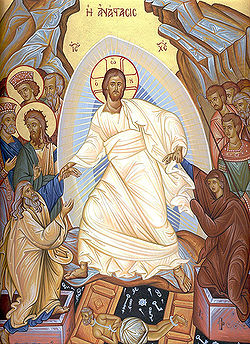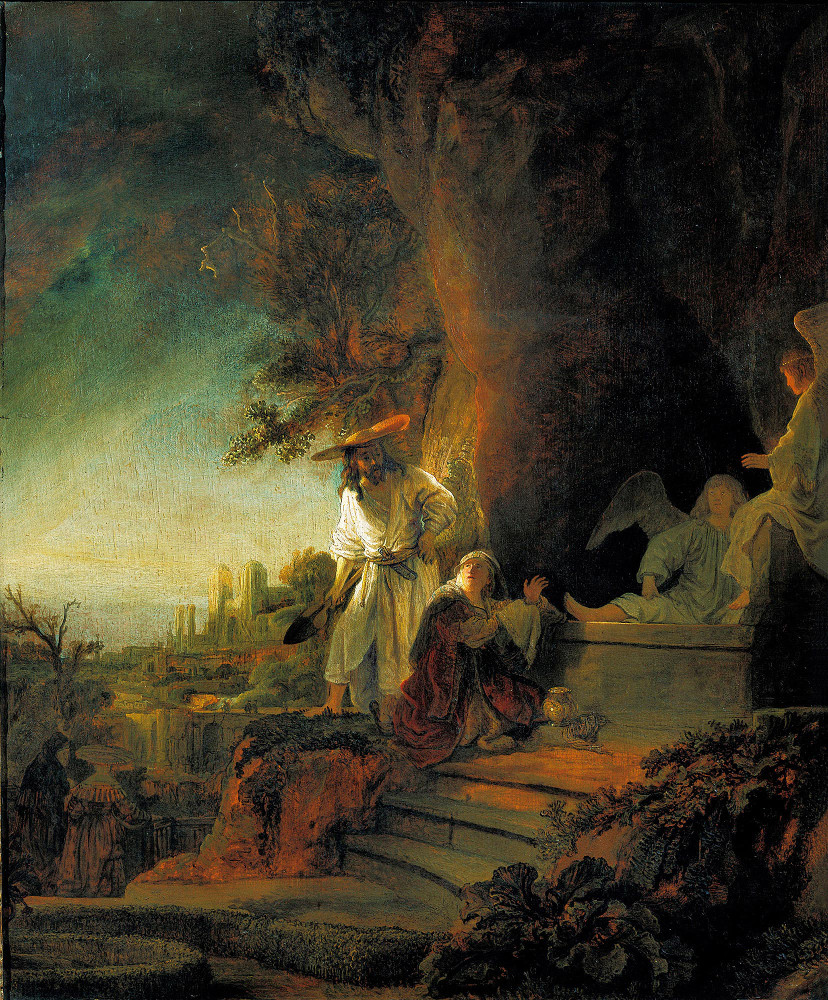
“An Easter postcard depicting the Easter Bunny…”
* * * *
 Today is Easter Sunday. That is, the day of the …
Today is Easter Sunday. That is, the day of the …
… festival and holiday celebrating the resurrection of Jesus from the dead, described in the New Testament as having occurred on the third day of his burial after his crucifixion by the Romans at Calvary [circa] 30 AD. It is the culmination of the Passion of Jesus, preceded by Lent (or Great Lent), a forty-day period of fasting, prayer, and penance.
And incidentally, the painting above left shows Jesus has “having kicked down the gates of Hades.” It also shows “Satan, depicted as an old man … bound and chained.”
Which pretty much sums up the Lesson of Easter. But what’s this about the Easter Bunny?
That tradition – first noted around 1682 – was based on folklore that had already been around awhile, and as practiced by German Lutherans. In turn, the Easter Bunny – or more accurately, the Easter Hare – “played the role of a judge,” evaluating whether children were good or bad, especially in the days leading up to “the start of the season of Eastertide.”
Which brings up the fact that Easter is “not just one day, but an entire season.” That full season is also called Eastertide, defined as that long period – 50 days – that runs from Easter Sunday to Pentecost. (See On Eastertide – and “artistic license”.” And for more on Pentecost, see “Happy Birthday, Church!”) But getting back to the tradition of the Easter Bunny:
In legend, the creature carries colored eggs in his basket, candy, and sometimes also toys to the homes of children, and as such shows similarities to Santa Claus or the Christkind, as they both bring gifts to children on the night before their respective holidays.
 One author noted the “hare was the sacred beast of Eastre (or Eostre), a Saxon goddess of Spring and of the dawn.” (The “Saxon goddess” is at right.) In turn, the goddess – called “Ēostre” or “Ostara” – is the “namesake of the festival of Easter in some languages.”
One author noted the “hare was the sacred beast of Eastre (or Eostre), a Saxon goddess of Spring and of the dawn.” (The “Saxon goddess” is at right.) In turn, the goddess – called “Ēostre” or “Ostara” – is the “namesake of the festival of Easter in some languages.”
Ēostre is attested solely by Bede in his 8th-century work The Reckoning of Time, where Bede states that during Ēosturmōnaþ [“Easter-month,” in general, the month of April], pagan Anglo-Saxons had held feasts in Ēostre’s honor, but that this tradition [was] replaced by the Christian Paschal month, a celebration of the resurrection of Jesus.
Which brings up the real reason for the Easter Season. It’s pretty much summed up in the painting below, by Rembrandt. (As told in Easter Season – AND BEYOND, from April 2015):
Mary Magdalen had just found Jesus’ grave empty, and asks a bystander what has happened. In her confusion she thinks the man is a gardener. Only when he replies with “Mary!” does she realize who she’s talking to. To illustrate Mary’s confusion, Jesus is often depicted as a gardener in this scene.
See also Mark 16:1-8. And as noted in Easter Season – AND BEYOND, the event celebrated on Easter Sunday has sparked an going debate that continues “even to this day.” On the one hand there is the idea – illustrated in El Greco‘s “The Resurrection.“ (Q.v.) It shows the Risen Messiah “in a blaze of glory … holding the white banner of victory over death.”
On the other hand there are all those Doubting Thomases. They are the “rationalists” among us who “can’t be persuaded by and through any direct evidence of the Resurrection.” Which is probably why the Sunday right after Easter is also known as Doubting Thomas Sunday. (See Second Sunday of Easter and/or John 20:19-31, and also Thomas the Apostle – Wikipedia.)
But for those of us who believe, we celebrate this day because – by and through it – Jesus gave us all power to become children of God. And that ain’t exactly chopped liver…
* * * *

“The Risen Christ Appearing to Mary Magdalen…”
* * * *
The upper image is courtesy of Easter – Wikipedia, the free encyclopedia.
 The “Jesus and Satan” image – shown in a larger version at left – is also courtesy of Easter – Wikipedia. The full caption: “Icon of the Resurrection, with Christ having kicked down the gates of Hades and pulling Adam and Eve out of the tombs. Christ is flanked by saints, and Satan, depicted as an old man, is bound and chained.”
The “Jesus and Satan” image – shown in a larger version at left – is also courtesy of Easter – Wikipedia. The full caption: “Icon of the Resurrection, with Christ having kicked down the gates of Hades and pulling Adam and Eve out of the tombs. Christ is flanked by saints, and Satan, depicted as an old man, is bound and chained.”
Re: “Christkind.” The term refers to “the traditional Christmas gift-bringer,” in parts of Europe and South America. “Promulgated by Martin Luther at the Protestant Reformation … many Protestants adopted this gift bringer…” As such, the “Lutheran Church promoted Christ as the children’s gift-giver, hoping to draw attention to the child for whom Christmas was named.” The Christkind is a “sprite-like child, usually depicted with blond hair and angelic wings. Martin Luther intended it to be a reference to the incarnation of Jesus as an infant.” Later, the “Christkind was adopted in Catholic areas of Germany during the 19th century.”
Re: “Power to become children of God.” See John 1:12, from one of the Daily Office Readings for today, April 16, 2017. See also Romans 8:14 and Romans 8:16: “For all who are led by the Spirit of God are sons of God,” and “The Spirit Himself testifies with our spirit that we are God’s children.”
The lower image is courtesy of “The Risen Christ Appearing to Mary Magdalen” – Art and the Bible. See also Rembrandt – Wikipedia, and/or Rembrandt van Rijn: Life and Work.